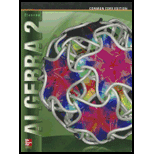
Concept explainers
(a)
Whether the event “sum of 10 or doubles” is mutually exclusive or not mutually exclusive, also find its probability.
(a)
Answer to Problem 2E
The event “sum of 10 or doubles” is not mutually exclusive.
Probability of the event is approx. 0.22.
Explanation of Solution
Given information:
Two dice are rolled.
Such that
Event occurs:
“sum of 10 or doubles”
Calculations:
Since the sum would be 10 when both die roll a 5 and also it would be a double (5, 5), the event will not be mutually exclusive.
We know that
When two dice are rolled,
The number of possible outcomes would be 36.
Such that
For the first die, there are 6 possibilities.
Then
For each number on the first die, there are 6 possibilities for the second die.
Now,
For sum of 10,
There are three possible outcomes:
(4, 6), (5, 5), (6, 4)
For doubles,
There are six possible outcomes:
(1, 1), (2, 2), (3, 3), (4, 4), (5, 5), (6, 6)
For getting 5 on both dice,
There is only one outcome:
(5, 5)
Now,
Probability for getting sum of 10,
Probability for getting doubles,
Probability for getting “sum of 10 and doubles”
Then
Apply general addition rule, for the probability of event “sum of 10 or doubles”:
Thus,
The event is not mutually exclusive with the probability of approx. 0.22.
(b)
Whether the event “sum of 6 or 7” is mutually exclusive or not mutually exclusive, also find its probability.
(b)
Answer to Problem 2E
The event“sum of 6 or 7” is mutually exclusive.
Probability of the event is approx. 0.31.
Explanation of Solution
Given information:
Two dice are rolled.
Such that
Event occurs:
“sum of 10 or doubles”
Calculations:
Since both dice cannot have sum of 6 or 7 at the same time, the event will be mutually exclusive.
We know that
When two dice are rolled,
The number of possible outcomes would be 36.
Such that
For the first die, there are 6 possibilities.
Then
For each number on the first die, there are 6 possibilities for the second die.
Now,
For sum of 6,
There are five possible outcomes:
(1, 5), (2, 4), (3, 3), (4, 2), (5, 1)
For sum of 7,
There are six possible outcomes:
(1, 6), (2, 5), (3, 4), (4, 3), (5, 2), (6, 1)
Now,
Probability for getting sum of 6,
Probability for getting sum of 7,
Then
Apply general addition rule for mutually exclusive events, for the probability for “sum of 6 or 7”:
Thus,
The event is mutually exclusive with the probability of approx. 0.31.
(c)
Whether the event “sum < 3 or sum > 10” is mutually exclusive or not mutually exclusive, also find its probability.
(c)
Answer to Problem 2E
The event “sum < 3 or sum > 10” is mutually exclusive.
Probability of the event is approx. 0.11.
Explanation of Solution
Given information:
Two dice are rolled.
Such that
Event occurs:
“sum of 10 or doubles”
Calculations:
Since the sum can be either less than 3 or greater than 10 when both dice are thrown, the event will be mutually exclusive.
For sum less than 3,
There is only one possible outcome:
(1, 1)
For sum greater than 10,
There are three possible outcomes:
(5, 6), (6, 5), (6, 6)
Since there are 4 possible outcomes that satisfy the requirement of getting sum less than 3 or greater than 10
Thus,
The probability for“sum < 3 or sum > 10”:
The event is mutually exclusive with the probability of approx. 0.11.
Chapter 0 Solutions
Glencoe Algebra 2 Student Edition C2014
Additional Math Textbook Solutions
College Algebra
Linear Algebra and Its Applications (5th Edition)
College Algebra
College Algebra (7th Edition)
A First Course in Probability (10th Edition)
 Algebra and Trigonometry (6th Edition)AlgebraISBN:9780134463216Author:Robert F. BlitzerPublisher:PEARSON
Algebra and Trigonometry (6th Edition)AlgebraISBN:9780134463216Author:Robert F. BlitzerPublisher:PEARSON Contemporary Abstract AlgebraAlgebraISBN:9781305657960Author:Joseph GallianPublisher:Cengage Learning
Contemporary Abstract AlgebraAlgebraISBN:9781305657960Author:Joseph GallianPublisher:Cengage Learning Linear Algebra: A Modern IntroductionAlgebraISBN:9781285463247Author:David PoolePublisher:Cengage Learning
Linear Algebra: A Modern IntroductionAlgebraISBN:9781285463247Author:David PoolePublisher:Cengage Learning Algebra And Trigonometry (11th Edition)AlgebraISBN:9780135163078Author:Michael SullivanPublisher:PEARSON
Algebra And Trigonometry (11th Edition)AlgebraISBN:9780135163078Author:Michael SullivanPublisher:PEARSON Introduction to Linear Algebra, Fifth EditionAlgebraISBN:9780980232776Author:Gilbert StrangPublisher:Wellesley-Cambridge Press
Introduction to Linear Algebra, Fifth EditionAlgebraISBN:9780980232776Author:Gilbert StrangPublisher:Wellesley-Cambridge Press College Algebra (Collegiate Math)AlgebraISBN:9780077836344Author:Julie Miller, Donna GerkenPublisher:McGraw-Hill Education
College Algebra (Collegiate Math)AlgebraISBN:9780077836344Author:Julie Miller, Donna GerkenPublisher:McGraw-Hill Education





